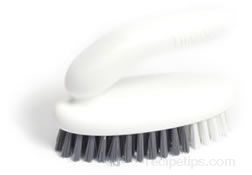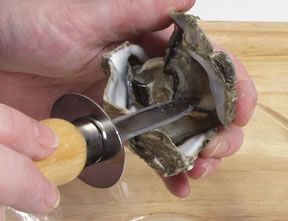|
What You Need

Stiff kitchen brush |

Oyster knife |
- If an oyster knife is unavailable, use a thin, short, dull knife. Do not use a sharp kitchen knife.
- Access to cool running water.
- A bowl to catch the liquor from the shell when opening.
- A towel that can be used to protect your hand while opening the shell. A heavy work glove will also protect your hand.
Check for Freshness
- Oysters are at their best if they are no more than four days old. Ask your fish monger for the harvest date.
- When at the market, the oysters should be stored in or on ice.
- Unless they have been shucked and frozen, oysters should be alive when you buy and cook them. If the shell is tightly closed, it is still alive. If the shell is slightly open, it should close promptly when tapped. If the shell is open and does not close when tapped, throw it out.
- Throw out any oysters that have broken shells.
Preparing Oysters
If you are not going to cook the oysters immediately, clean the shells with a kitchen brush, place in a bowl, cover the bowl with a damp towel and refrigerate. Oysters will keep for 2 to 3 days; however, they are best when cooked as soon as possible. Shucked oysters that have not been cooked can be stored in their liquor, covered and refrigerated for up to 2 days.
If you are cooking oysters in the shell, do not open and remove the oyster from the shell. Wash the oysters with a stiff kitchen brush under cool running water and remove any hard encrustations from the shell with a rigid kitchen knife.
Never eat an oyster whose shell is not open after cooking.
Opening Oysters
Before you begin: Chill the oysters in the freezer for an hour or longer to make them easier to open. When you remove the oysters from the freezer, allow them to rest for a few minutes before inserting the clam knife between the top shell and bottom shell.
Scrub oysters under cool running water using a stiff kitchen brush. Scrape any hard encrustations from the shell with a rigid kitchen knife.
| Over a bowl, hold the oyster firmly in your hand and insert the oyster knife between the top shell and bottom shell. A towel can be used to protect your hand, or a heavy work glove. Twist the knife to pry the halves apart. Work the knife around to the hinge muscle and cut through it. The bowl will catch the liquor from the oyster. |
 |
| Open the shell. Holding the deeper shell downward, slide the knife between the oyster and the top shell. Detach the oyster from the top shell. Slip the knife under the oyster and remove it from the bottom shell. |
 |
| You are now ready to prepare the oyster. |
 |
| Strain the liquor from the shell before using to remove any bit of shell that may have broken off. |
Storing Oysters
- If you are not going to cook the oysters immediately after purchasing, clean the shell with a kitchen brush under cool running water. Place in a bowl and cover with a damp towel. Refrigerate. The key to keeping oysters fresh is to place them in the coldest area of the refrigerator. Oysters will keep for 2 to 3 days, however, they are best when cooked as soon as possible.
- Oysters that have been freshly shucked should be submerged in their own liquor and stored in the refrigerator for up to 2 days.
- Freeze freshly shucked oysters in an air tight container with the oyster liquor. Thaw the frozen oysters in the refrigerator overnight.
| Do not store live oysters in air tight containers or they will die. |
|

